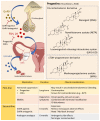A Lifelong Impact on Endometriosis: Pathophysiology and Pharmacological Treatment
- PMID: 37108664
- PMCID: PMC10139092
- DOI: 10.3390/ijms24087503
A Lifelong Impact on Endometriosis: Pathophysiology and Pharmacological Treatment
Abstract
Endometriosis is a chronic inflammatory disease associated with bothersome symptoms in premenopausal women and is complicated with long-term systemic impacts in the post-menopausal stage. It is generally defined by the presence of endometrial-like tissue outside the uterine cavity, which causes menstrual disorders, chronic pelvic pain, and infertility. Endometriotic lesions can also spread and grow in extra-pelvic sites; the chronic inflammatory status can cause systemic effects, including metabolic disorder, immune dysregulation, and cardiovascular diseases. The uncertain etiologies of endometriosis and their diverse presentations limit the treatment efficacy. High recurrence risk and intolerable side effects result in poor compliance. Current studies for endometriosis have paid attention to the advances in hormonal, neurological, and immunological approaches to the pathophysiology and their potential pharmacological intervention. Here we provide an overview of the lifelong impacts of endometriosis and summarize the updated consensus on therapeutic strategies.
Keywords: angiogenesis; endometriosis; inflammation; medical therapy; pathogenesis; pharmacological inhibitors.
Conflict of interest statement
The authors declare no conflict of interest.
Figures






References
Publication types
MeSH terms
Grants and funding
LinkOut - more resources
Full Text Sources
Medical

